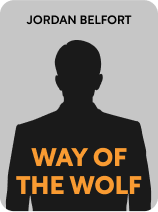

This article is an excerpt from the Shortform book guide to "Way of the Wolf" by Jordan Belfort. Shortform has the world's best summaries and analyses of books you should be reading.
Like this article? Sign up for a free trial here .
What questions should you ask in sales? What is the point of asking questions in sales?
There are two goals when questioning your prospects: determining their interest in your products, and learning about their problems and concerns. Each goal requires asking different questions.
Keep reading for Jordan Belfort’s advice on what questions you should ask a prospect and why.
Sales Questioning
Tone and body language work closely with the next technique—questioning. In the Straight Line System, questions and answers are not idle small talk or tangents. As noted in Chapters 2-3, your questions must be focused and have two purposes: to build rapport and to gather information. Integrating your questions with proper tone and body language makes them more effective.
Asking questions in sales has two goals:
- To qualify the prospect (determine if he has the means to buy your product and at least some interest), and determine where he falls on the certainty scale
- To learn about problems and concerns hindering a sale so you can address them and move him to level 10 certainty
As noted in Chapter 1, you can’t sell to someone at a very low level of certainty about your product, you, or your company. This chapter discusses how to quickly weed out non-buyers, and then to develop rapport and ultimately make sales to your remaining prospects.
A marketing professional department helps to lay the groundwork for your sales conversation by:
- Identifying potentially good prospects (leads)
- Designing a strategy and message for reaching and hooking them with an offer that prompts them to respond and thus connect with the company (in marketing jargon, pulling them into the sales funnel).
- Turning these names or leads over to the sales staff, who convert them into customers
(Shortform note: For an in-depth discussion of marketing, read our guides to The 22 Immutable Laws of Marketing and Building a StoryBrand.)
Although a marketing strategy is a start, the sales staff must refine the prospect list further through focused questioning. Belfort says you’ll be lucky if even 50% of your leads turn out to be qualified buyers. (Shortform note: Getting a sale is even harder. Overall, lead-to-sale conversion rates are modest and vary by industry, with the highest rate in the financial services industry at 10%; B2B sales are more complex than B2C sales, which results in lower conversion rates for B2Bs.)
In Chapter 2, we covered some initial questions that a broker selling investments might ask prospects—for instance, the prospect’s current financial status, their concerns when it comes to investing, and past experiences. Of course, to get honest answers to questions like these, you’ll have had to decisively establish your credibility and rapport in the first few seconds of your conversation.
Further, in this chapter, Belfort offers a set of prospecting principles for sorting out the remaining non-buyers on your prospect list. Before explaining the principles, he describes the two types of non-buyers (whom you must eliminate) and two types of buyers (whom you can close) likely to be in your sales funnel:
Non-buyers
1) Casual shoppers (30-40% of leads): These people are “just looking” with no intention of buying. They waste your time by seeming to move through the sales process, but they never agree to a sale. Besides wasting the seller’s time, they undermine her confidence: If she can’t close when everything is on track, she must be a poor salesperson.
How to recognize casual shoppers:
- They over-examine and over-analyze the product.
- Their expressions of interest (wow!) are over the top.
- When you ask about their finances, they seem either too confident or too vague.
2) Accidentals (-5%): These people have no interest in your product and shouldn’t have been in your funnel to start with. Either someone else pushed them to look at something they’re not interested in, or they mistakenly clicked on your website and were added to a marketing list.
Accidentals are easy to identify compared to casual shoppers, but you should beware of both, and eliminate them as quickly as possible so you can spend your time on two types of likely buyers.
Buyers
1) Super-motivated buyers (10-20%): In contrast to casual shoppers, super-motivated buyers want to buy now. They have a pain point or problem they’ve made up their mind to solve, they know they want your product, and they want it immediately.
2) Comparison buyers (30-40%): These buyers are interested in your product, but they don’t feel a sense of urgency to buy because they’re not bothered by a pain or problem. As a result, they feel they have the upper hand, and so want to shop around and take their time in deciding on a product.
| Stakeholders in a Sale Have Differing Interests Similarly, in The Psychology of Selling, Brian Tracy identifies six buyer types (reluctant, certain, analytical, relationship, directive, and social), and he recommends writing several versions of your sales presentation so you can switch to a more effective one when you determine what type of buyer you’re dealing with. Recognizing these buyer types may be useful in B2C sales. However, in complex B2B sales, it may be more helpful to classify buyers by their positions as stakeholders—such as the person controlling the budget, the user, technical buyer, and the implementer. All of these stakeholders have an influence on the buying decision in a large company, so a salesperson will have a better chance of building broad support and closing if she understands and appeals to their specific interests and concerns. The Challenger Sale addresses how sales reps can tailor their message to different stakeholders and thus build support throughout the organization for the eventual sale. To do so, you need to understand such things as each stakeholder’s business priorities, the outcomes they care about, the economic drivers affecting those outcomes, and the results they need to deliver. |
Principles of Prospecting
Ask information-gathering questions, while maintaining rapport, to eliminate non-buyers and get a handle on how to move the likely buyers along the straight line to certainty and a sale.
Since super-motivated buyers are ready to buy immediately, you won’t have to spend a lot of time on them once you know who they are. Your challenge is to identify and turn comparison buyers into super-motivated buyers by emphasizing their pain, and close them.
Here are several prospecting principles to keep in mind during your information gathering and filtering:
- Start with less intrusive questions and work up to more intrusive questions. For example, start with general questions about a prospect’s neighborhood or work before asking how much money they make or about their financial concerns. The prospect will become desensitized to your intrusiveness and simultaneously feel greater rapport as they give you more information.
- Use a script instead of winging it. Planning your questions and creating a logical sequence (so you don’t jump around among topics). (Shortform note: Similarly, the SPIN Selling method is based on a specific sequence of four categories of questions in which each one builds on the previous category.) The next chapter explains how to create a script.
- Uncover your prospect’s problems and pain points, but instead of solving the pain, highlight and amplify it by asking future pacing questions—for example, “I can see why that worries you: These problems (such as a leaky roof) only get worse and more costly with time…there’s no cheap solution.” Mentally file the prospect’s pain information for future use in looping or closing.
- Once you’ve qualified a prospect, transition to your sales pitch or presentation: “Based on what you’ve told me, Jane, our product would be a perfect fit. Let me explain why.” Conversely, eliminate the unqualified prospects or non-buyers, but do so gracefully because they could still become buyers in the future: “Based on what you’ve said, this product isn’t a great fit. I’m sorry but I don’t want to sell you something you won’t be 100% satisfied with.”
(Shortform note: Alternatively, in New Sales. Simplified., Mike Weinberg defines a three-step prospecting process: targeting (creating a foolproof prospect list), developing effective sales tools, and planning/executing a sale. Compared to Belfort’s process, Weinberg’s is more explicit and requires more research and preparation—for example, he uses a set of parameters for including a name on your prospect list in the first place, and creates a presentation tailored to each prospect. Belfort’s prospecting method is simpler and focuses mostly on sales techniques and a script that works for all sales.)

———End of Preview———
Like what you just read? Read the rest of the world's best book summary and analysis of Jordan Belfort's "Way of the Wolf" at Shortform .
Here's what you'll find in our full Way of the Wolf summary :
- How to sell like Jordan Belfort, the Wolf of Wall Street
- The 4 steps of the Straight Line selling method
- The 3 types of certainty you have to create to make a successful sale






